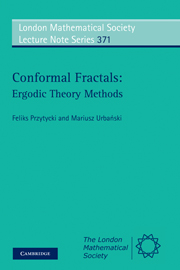Book contents
- Frontmatter
- Contents
- Introduction
- 1 Basic examples and definitions
- 2 Measure-preserving endomorphisms
- 3 Ergodic theory on compact metric spaces
- 4 Distance-expanding maps
- 5 Thermodynamical formalism
- 6 Expanding repellers in manifolds and in the Riemann sphere: preliminaries
- 7 Cantor rep ellers in the line; Sullivan's scaling function; application in Feigenbaum universality
- 8 Fractal dimensions
- 9 Conformal expanding repellers
- 10 Sullivan's classification of conformal expanding repellers
- 11 Holomorphic maps with invariant probability measures of positive Lyapunov exponent
- 12 Conformal measures
- References
- Index
Introduction
Published online by Cambridge University Press: 05 April 2013
- Frontmatter
- Contents
- Introduction
- 1 Basic examples and definitions
- 2 Measure-preserving endomorphisms
- 3 Ergodic theory on compact metric spaces
- 4 Distance-expanding maps
- 5 Thermodynamical formalism
- 6 Expanding repellers in manifolds and in the Riemann sphere: preliminaries
- 7 Cantor rep ellers in the line; Sullivan's scaling function; application in Feigenbaum universality
- 8 Fractal dimensions
- 9 Conformal expanding repellers
- 10 Sullivan's classification of conformal expanding repellers
- 11 Holomorphic maps with invariant probability measures of positive Lyapunov exponent
- 12 Conformal measures
- References
- Index
Summary
This book is an introduction to the theory of iteration of expanding and non-uniformly expanding holomorphic maps and topics in geometric measure theory of the underlying invariant fractal sets. Probability measures on these sets yield information on Hausdorff and other fractal dimensions and properties. The book starts with a comprehensive chapter on abstract ergodic theory, followed by chapters on uniform distance-expanding maps and thermo-dynamical formalism. This material is applicable in many branches of dynamical systems and related fields, far beyond the applications in this book.
Popular examples of the fractal sets to be investigated are Julia sets for rational functions on the Riemann sphere. The theory, which was initiated by Gaston Julia [1918] and Pierre Fatou [1919–1920], has become very popular since the publication of Benoit Mandelbrot's book [Mandelbrot 1982] with beautiful computer generated illustrations. Top mathematicians have since made spectacular progress in the field over the last 30 years.
Consider, for example, the map f(z)= z2 for complex numbers z. Then the unit circle S1 = {∣z∣ =1} is f-invariant, f(S1)= S1 = f−1(S1). For c ≈ 0, c ≠ 0 and fc(z)= z2 + c, there still exists an fc-invariant set J(fc) called the Julia set of fc, close to S1, homeomorphic to S1 via a homeomorphism h satisfying the equality f ∘ h = h ∘ fc. However, J(fc) has a fractal shape.
- Type
- Chapter
- Information
- Conformal FractalsErgodic Theory Methods, pp. 1 - 7Publisher: Cambridge University PressPrint publication year: 2010

